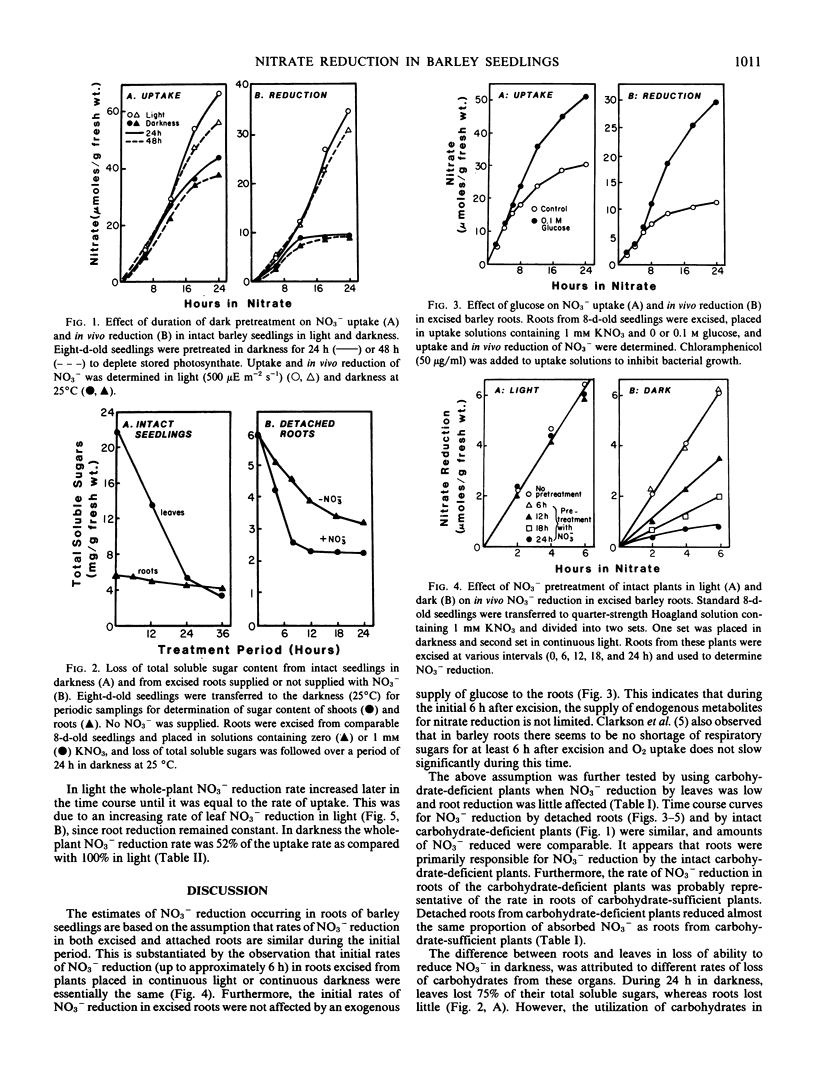Abstract
In vivo NO3− reduction in roots and shoots of intact barley (Hordeum vulgare L. var Numar) seedlings was estimated in light and darkness. Seedlings were placed in darkness for 24 hours to make them carbohydrate-deficient. During darkness, the leaves lost 75% of their soluble carbohydrates, whereas the roots lost only 15%. Detached leaves from these plants reduced only 7% of the NO3− absorbed in darkness. By contrast, detached roots from the seedlings reduced the same proportion of absorbed NO3−, as did roots from normal light-grown plants. The rate of NO3− reduction in the roots accounted for that found in the intact dark-treated carbohydrate-deficient seedlings. The rates of NO3− reduction in roots of intact plants were the same for approximately 12 hours, both in light and darkness, after which the NO3− reduction rate in roots of plants placed in darkness slowly declined. In the dark, approximately 40% of the NO3− reduction occurred in the roots, whereas in light only 20% of the total NO3− reduction occurred in roots. A lesser proportion was reduced in roots because the leaves reduced more nitrate in light than in darkness.
Full text
PDF




Selected References
These references are in PubMed. This may not be the complete list of references from this article.
- Aslam M., Huffaker R. C., Rains D. W., Rao K. P. Influence of light and ambient carbon dioxide concentration on nitrate assimilation by intact barley seedlings. Plant Physiol. 1979 Jun;63(6):1205–1209. doi: 10.1104/pp.63.6.1205. [DOI] [PMC free article] [PubMed] [Google Scholar]
- Chantarotwong W., Huffaker R. C., Miller B. L., Granstedt R. C. In vivo nitrate reduction in relation to nitrate uptake, nitrate content, and in vitro nitrate reductase activity in intact barley seedlings. Plant Physiol. 1976 Apr;57(4):519–522. doi: 10.1104/pp.57.4.519. [DOI] [PMC free article] [PubMed] [Google Scholar]
- Radin J. W., Parker L. L., Sell C. R. Partitioning of Sugar between Growth and Nitrate Reduction in Cotton Roots. Plant Physiol. 1978 Oct;62(4):550–553. doi: 10.1104/pp.62.4.550. [DOI] [PMC free article] [PubMed] [Google Scholar]
- Sanderson G. W., Cocking E. C. Enzymic Assimilation of Nitrate in Tomato Plants. I. Reduction of Nitrate to Nitrite. Plant Physiol. 1964 May;39(3):416–422. doi: 10.1104/pp.39.3.416. [DOI] [PMC free article] [PubMed] [Google Scholar]
- Stocking C. R., Larson S. A chloroplast cytoplasmic shuttle and the reduction of extraplastid NAD. Biochem Biophys Res Commun. 1969 Oct 8;37(2):278–282. doi: 10.1016/0006-291x(69)90731-1. [DOI] [PubMed] [Google Scholar]
- Thayer J. R., Huffaker R. C. Determination of nitrate and nitrite by high-pressure liquid chromatography: comparison with other methods for nitrate determination. Anal Biochem. 1980 Feb;102(1):110–119. doi: 10.1016/0003-2697(80)90325-5. [DOI] [PubMed] [Google Scholar]


